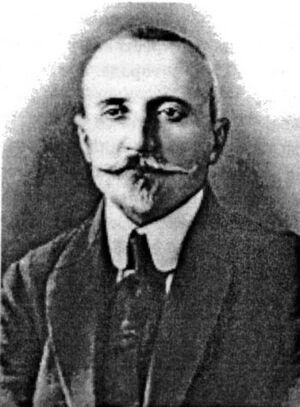Arsen Kotsoyev facts for kids
Quick facts for kids
Arsen Kotsoyev
Коцойты Арсен |
|
|---|---|
 |
|
| Born | January 15, 1872 Gizel, Terek Oblast |
| Died | February 4, 1944 (aged 72) Vladikavkaz |
| Pen name | A. K., Botash, Xabosh |
| Occupation | Prose writer, translator, opinion writer |
| Nationality | Ossetian |
Arsen Kotsoyev (Ossetian: Коцойты Арсен, romanized: Kocojty Arsen; born January 15, 1872 – died February 4, 1944) was a very important Ossetian writer. He helped create modern Ossetian prose, which means he wrote stories and articles in a new, influential way. He also greatly shaped the modern Ossetic language and how it is used.
Arsen Kotsoyev was involved in all the first Ossetian newspapers and magazines. He was known as a top Ossetian journalist and writer. Today, streets in Vladikavkaz and Beslan are named after him. His works are a key part of school lessons on Ossetian literature.
Life
Arsen Kotsoyev was born into a poor family in a village called Gizel. This village was in the Ossetian countryside, near Vladikavkaz, in a region then known as Terek Oblast.
When he was nine years old, he started attending the local school. There, he discovered a large collection of books. These books helped him learn a lot and grow his knowledge. After school, he went to study at the Ardon Orthodox Seminary. However, he had to leave the seminary because he became very ill.
He returned to his home village of Gizel. There, he began writing short articles for newspapers in the North Caucasus region. He also worked as a teacher at the local school.
In 1902, Arsen Kotsoyev took part in an uprising in Gizel. Because of this, he was forced to leave the region. He decided to move to South Ossetia. In his new home, he continued to work as a teacher. He also kept writing short stories and essays.
In 1910, he started his own magazine called "Æфсир" (Æfsir). This name means "ear of wheat." The magazine was published in Tiflis, which is now Tbilisi, the capital of Georgia. Only 14 issues of "Æфсир" were ever published. However, it had a huge impact on Ossetian literature and journalism. Many famous Ossetian stories and articles were first printed in this magazine.
In 1912, Kotsoyev moved to Saint Petersburg. He worked in many different places there. One of his jobs was at Pravda, a famous newspaper connected to Vladimir Lenin. Even though he grew up in a village, he knew Russian very well. This skill allowed him to proofread Russian newspapers.
After the October Revolution, Arsen Kotsoyev became even more famous. He worked for various newspapers and magazines. He also held jobs in education and related fields. He passed away in Vladikavkaz. His burial place is in the yard of the Literature Museum there.
Work
Most of Arsen Kotsoyev's short stories are quite sad. They often tell tales about the strict traditions of people living in the mountains. For example, he wrote about "blood revenge" (vendetta), which is when families try to get revenge for harm done to them. He also wrote about "irad," which was a payment made by the groom's family to the bride's family. Superstitions, or old beliefs not based on facts, were another topic he explored.
Kotsoyev often wrote about people from the traditional mountain areas. He showed what happened when they moved to a new world that was more like Europe. He explored how their lives changed in these new surroundings.
Arsen Kotsoyev also translated many works into the Ossetic language. This included several stories written by the famous Russian poet and writer, Pushkin.
See also
 In Spanish: Arsén Kotsóyev para niños
In Spanish: Arsén Kotsóyev para niños

